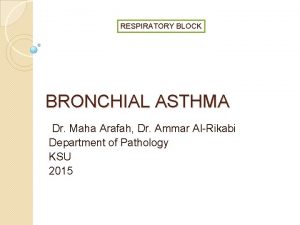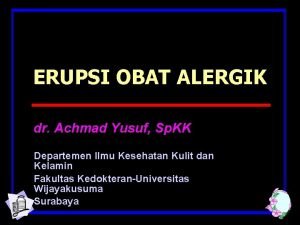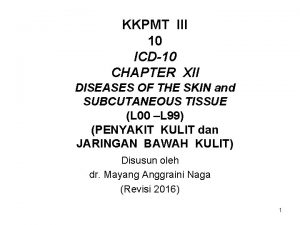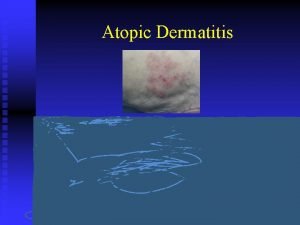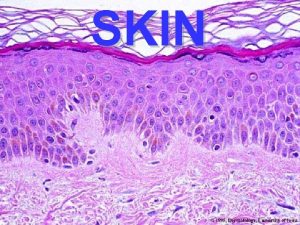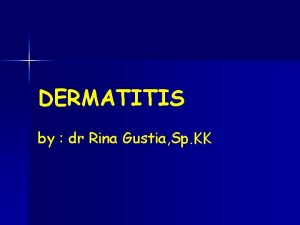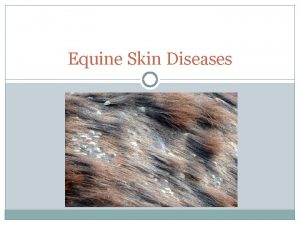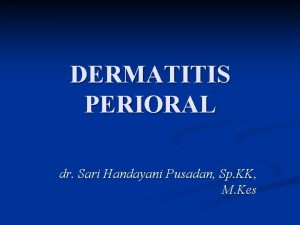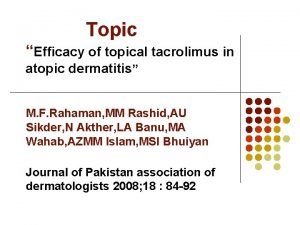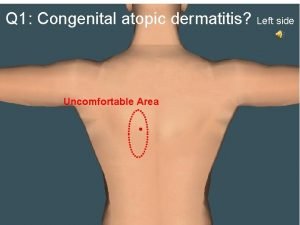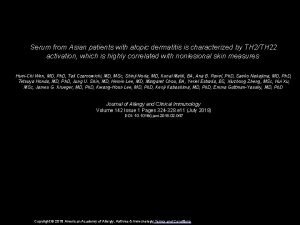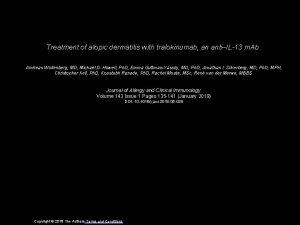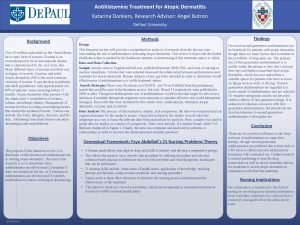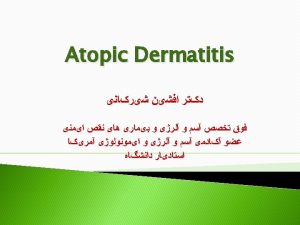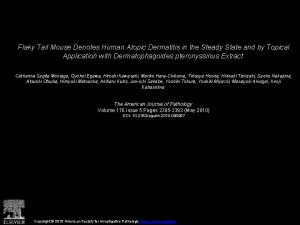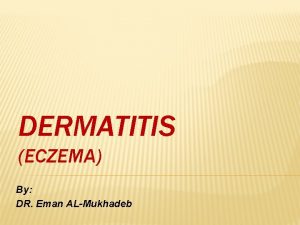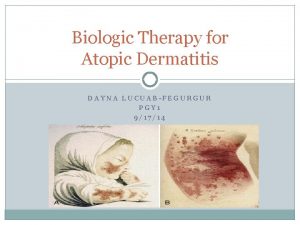Atopic Dermatitis Yardstick Practical Recommendations for an Evolving

























- Slides: 25


Atopic Dermatitis Yardstick: Practical Recommendations for an Evolving Therapeutic Landscape Mark Boguniewicz, MD Luz Fonacier, MD Emma Guttman-Yassky, MD, Ph. D Peck Y. Ong, MD Jonathan Silverberg, MD, Ph. D Judith Rosen Farrar, Ph. D Ann Allergy Asthma Immunol. Jan 2018; 120: 10 -22

Immunopathologic Mechanisms Underlying Atopic Dermatitis Boguniewicz M, et al. Ann Allergy Asthma Immunol. Jan 2018; 120: 10 -22

Step-care Management of Atopic Dermatitis Boguniewicz M, et al. Ann Allergy Asthma Immunol. Jan 2018; 120: 10 -22

Some Characteristics of Moderate to Severe Atopic Dermatitis Boguniewicz M, et al. Ann Allergy Asthma Immunol. Jan 2018; 120: 10 -22

The Atopic Dermatitis Yardstick Flow Diagram Boguniewicz M, et al. Ann Allergy Asthma Immunol. Jan 2018; 120: 10 -22

Images of Patients with Severe AD Boguniewicz M, et al. Ann Allergy Asthma Immunol. Jan 2018; 120: 10 -22

Clinical Approach to the Patient with Refractory Atopic Dermatitis Neema Izadi, MD, MS Donald Y. M. Leung, MD, Ph. D Izadi N, Leung DYM. Ann Allergy Asthma Immunol. Jan 2018; 120: 23 -33

Clinical Approach to Patient with Refractory AD Key Messages • The approach to refractory AD requires a step-wise approach to rule out other diagnoses, confirm adequate first-line therapy, and rule out exacerbating factors prior to implementing secondline therapies • Proactive skin care is paramount to prevent AD flares since it is difficult to identify triggers unless the patient is cleared first • Consider infection, allergen exposures, chronic scratching and behavioral factors using a multidisciplinary approach • Systemic therapies should be considered after confirming adherence to first line approaches Izadi N, Leung DYM. Ann Allergy Asthma Immunol. Jan 2018; 120: 23 -33

Case with Difficult to Treat Atopic Dermatitis A B Initial photo on admission (A) and improvement on the body only after use of wet wraps (B). C D Difficult to treat eczematous lesion on the left arm. Initial photo on admission (C) and improvement only after starting topical tacrolimus (D). Izadi N, Leung DYM. Ann Allergy Asthma Immunol. Jan 2018; 120: 23 -33

Approach to Patient with AD Who Does Not Respond to Routine Skin Care Step 1: Confirm diagnosis of AD Step 2: Ensure proper patient education about skin barrier protection and anti-inflammatory repair Step 3: Identify and control AD triggers including allergens, irritants, infection and behavioral factors Step 4: Proactive topical anti-inflammatory therapy including twice weekly TCS or alternate day TCI Step 5: Second line therapy including dupilumab (adults only), phototherapy, cyclosporin, methotrexate and azathioprine Izadi N, Leung DYM. Ann Allergy Asthma Immunol. Jan 2018; 120: 23 -33

Severe AD with MRSA Skin Infection Initial photo on admission (left) and after MRSA decolonization and supervised skin care in a multidisciplinary day program (right). Izadi N, Leung DYM. Ann Allergy Asthma Immunol. Jan 2018; 120: 23 -33

Severe AD with Significant Signs of Excoriation Initial photo on admission (left) and after wet wrap therapy (right). Izadi N, Leung DYM. Ann Allergy Asthma Immunol. Jan 2018; 120: 23 -33

Wet Wrap Therapy Procedure for Entire Body WWT can be adapted for individual areas as needed. (A) Soaking bath for 15 -20 minutes. (B) Apply topical corticosteroids to affected areas and emollients to unaffected areas on the face and body. (C) Dress in wet socks to hands and feet. (D) Dress in wet pajamas. (E) Place a second layer of dry socks over hands and feet. (F) Place a second layer of dry pajamas. (G) Place a wet layer of gauze around the face followed by a dry layer. (H) Be sure to leave space for the eyes, nose, and mouth. Izadi N, Leung DYM. Ann Allergy Asthma Immunol. Jan 2018; 120: 23 -33

Differential for Refractory Atopic Dermatitis Izadi N, Leung DYM. Ann Allergy Asthma Immunol. Jan 2018; 120: 23 -33

Behavioral and Education Reasons for Poor Responses Izadi N, Leung DYM. Ann Allergy Asthma Immunol. Jan 2018; 120: 23 -33

Immunologic, Microbial and Epithelial Interactions in Atopic Dermatitis Patrick Brunner, MD Donald Y. M. Leung, MD, Ph. D Emma Guttman-Yassky, MD, Ph. D Brunner PM, Leung DYM, Guttman-Yassky E. Ann Allergy Asthma Immunol. Jan 2018; 120: 34 -41

Immunologic, Microbial and Epithelial Interactions in AD Key Messages • AD is associated with Type 2 immune activation with variable activation of other immune axes depending upon the specific patient population • FLG loss-of-function mutation is the strongest identified risk factor for AD but only present in a minority of patients • AD flares are associated with decreased diversity of the skin microbiota with increased abundance of S. aureus • Skin commensal bacteria are protective against S. aureus via production of antimicrobial peptides • Increased blood inflammatory and cardiovascular mediators, abnormalities in non-lesional skin and associated allergic comorbidities suggest AD’s systemic nature Brunner PM, Leung DYM, Guttman-Yassky E. Ann Allergy Asthma Immunol. Jan 2018; 120: 34 -41

Immune Cell Subsets Mediating Local as well as Potentially System Inflammation Brunner PM, Leung DYM, Guttman-Yassky E. Ann Allergy Asthma Immunol. Jan 2018; 120: 34 -41

Cytokine Pathways Relevant to Atopic Dermatitis as Revealed in Clinical Trials Brunner PM, Leung DYM, Guttman-Yassky E. Ann Allergy Asthma Immunol. Jan 2018; 120: 34 -41

Role of Behavioral Health in Management of Pediatric Atopic Dermatitis Mary D. Klinnert, Ph. D, Genery Booster, Ph. D, Mandy Copeland, MSW, Jennifer Moyer Darr, MSW, Lisa J. Meltzer, Ph. D, Michael Miller, MSW, Alyssa Oland, Ph. D, Shauna Perry, MA, Brian K. Wise, MD, Bruce G. Bender, Ph. D Klinnert MD, et al. Ann Allergy Asthma Immunol. Jan 2018; 120: 42 -48

Role of Behavioral Health in Management of Pediatric Atopic Dermatitis Key Messages • Comprehensive management of AD must address not only the skin disease, but also associated behavioral, emotional, and interpersonal complications and consequences • Behavioral Health clinicians work with physicians to: • Help individuals and families interrupt the itch-scratch cycle • Facilitate development and maintenance of effective skin care routines • Address sleep disturbances and behavioral impediments to skin care • Enhance family coping skills such as parenting, stress management • Improve patients and families’ quality of life in the context of daily activities including school, work, sports, and peer encounters Klinnert MD, et al. Ann Allergy Asthma Immunol. Jan 2018; 120: 42 -48

Anguish and Misery of Severe Atopic Dermatitis Klinnert MD, et al. Ann Allergy Asthma Immunol. Jan 2018; 120: 42 -48

Model of Behavioral Health Treatment Approach for Pediatric Atopic Dermatitis and Allergic Conditions Klinnert MD, et al. Ann Allergy Asthma Immunol. Jan 2018; 120: 42 -48

MY ITCHY SKIN HOW TO HELP YOUR ITCHY SKIN WITHOUT SCRATCHING! 1. BECOME AWARE OF SCRATCHING • My atopic dermatitis (eczema) makes my skin itch. Scratching feels good, but I know that it will just make it itchier and worse later on. • I sometimes need to be reminded that I am scratching. Grown-ups can use kind signals to remind me, for example, touching my hand, giving me a secret signal, or _______. 2. QUICK RELIEF • I need to do something to make my skin feel better right away. • I can choose things to do that help me to feel better right away, like put cream on, pat the itchy spot, put a cold cloth on it, or _______. 3. DISTRACT YOURSELF • After I feel a little better, I should get interested in something else. I can choose things to do to take my mind off of my skin, like playing with friends, reading, doing artwork, or _______. • It is also good to find something for my fingers to do, like squeezing a ball, playing with Legos, painting my nails, or _______. Klinnert MD, et al. Ann Allergy Asthma Immunol. Jan 2018; 120: 42 -48
 Atopic dermatitis yardstick
Atopic dermatitis yardstick Atopic dermatitis vs contact dermatitis
Atopic dermatitis vs contact dermatitis Atopic dermatitis pathophysiology
Atopic dermatitis pathophysiology Hanifin rajka atopic dermatitis
Hanifin rajka atopic dermatitis Hospital university of pennsylvania
Hospital university of pennsylvania Yardstick
Yardstick Yardstick of value
Yardstick of value Types of bronchial asthma
Types of bronchial asthma Non atopic asthma
Non atopic asthma Key evolving signature
Key evolving signature Evolving
Evolving Evolving design
Evolving design A framework for clustering evolving data streams
A framework for clustering evolving data streams Hairdressing dermatitis
Hairdressing dermatitis Retinody
Retinody Patogenesis dermatitis kontak iritan
Patogenesis dermatitis kontak iritan Seborrheric dermatitis
Seborrheric dermatitis Gora phc palghar
Gora phc palghar Icd-10 dermatitis kontak alergi
Icd-10 dermatitis kontak alergi Treatment contact dermatitis
Treatment contact dermatitis Stasis dermatitis
Stasis dermatitis Patogenesis dermatitis kontak iritan
Patogenesis dermatitis kontak iritan Horse rain rot
Horse rain rot Integument medical term
Integument medical term Dermatitis perioral treatment
Dermatitis perioral treatment Cecilia gomez melendez
Cecilia gomez melendez







